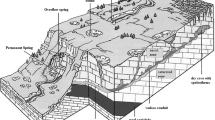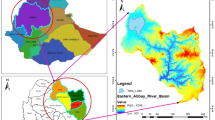Abstract
Catchment scale hydrological models are promising tools for simulating the effect of catchment-specific processes and management on soil and water resources. Here, we present a model intercomparison study of runoff simulations using three different semi-distributed rainfall-runoff catchment models. The objective of this study was to demonstrate the applicability of the Hydrologiska Byrans Vattenavdelning (HBV-Light); Precipitation, Evapotranspiration and Runoff Simulator for Solute Transport (PERSiST); and INtegrated CAtchment (INCA) models on Somogybabod Catchment, near Lake Balaton, Hungary.
The models were calibrated and validated against observed discharge data at the outlet of the catchment for the period of January 1, 2006 -July 12, 2015. Model performance was evaluated using graphical representations, e.g. daily and monthly hydrographs and Flow Duration Curves (FDC) and model evaluation statistic; Nash-Sutcliffe efficiency (NSE) and coefficient of determination (R2). The simulation results showed that the models provided good estimates of monthly average discharge (0.60-0.90 NSE; 0.60-0.91 R2) and satisfactory results for daily discharge (0.46-0.62 NSE; 0.50-0.67 R2). We found that the application of hydrological models serves as a powerful basis for ensemble modelling of average runoff and could enhance our understanding of the eco-hydrological and transport processes within catchments. On the other hand, it can highlight the uncertainty of model forecasts and the importance of goal specific evaluation.
Similar content being viewed by others
References
Dagnew D.C., Guzman C.D., Zegeye A.D., Tibebu T.Y., Getaneh M., Abate S., Zemale F.A., Ayana E.K., Tilahun S.A. & Steenhuis T.S. 2015. Impact of conservation practices on runoff and soil loss in the sub-humid Ethiopian Highlands: The Debre Mawi watershed. J. Hydrol. Hydromech. 63: 210–219.
Farkas C., Gelybó G., Bakacsi Z., Horel Á., Hagyó A., Dobor L., Kása I. & Tóth E. 2014. Impact of expected climate change on soil water regime under different vegetation conditions. Biologia 69: 1510–1519.
Farkas C., Kvćrnř S., Engebretsen A., Barneveld R. & Deelstra J. 2016. Applying profile- and catchment-based mathematical models for evaluating the run-off from a Nordic catchment. J. Hydrol. Hydromech. 64: 218–225.
Institute of Geodesy, Cartography and Remote Sensing (FOMI). 1979. Contoured topographic maps at scale 1: 10000. Hungarian Unified Map Projection System.
Futter M.N., Erlandsson M., Butterfield D.A., Whitehead P.G., Oni S.K. & Wade A.J. 2014. PERSiST: a flexible rainfallrunoff modelling toolkit for use with the INCA family of models. Hydrol. Earth Syst. Sci. 18: 855–873.
Golmohammadi G., Prasher S., Madani A. & Rudra R. 2014. Evaluating three hydrological distributed watershed models: MIKE-SHE, APEX, SWAT. Hydrology 1: 20–39.
Hart M.R., Quin B.F. & Nguyen M.L. 2004. Phosphorus run-off from agricultural land and direct fertilizer effects: A review. J. Environ. Qual. 33: 1954–1972.
Holko L., Kostka Z., Lichner L. & Píš V. 2006. Variation of nitrates in runoff from mountain and rural areas. Biologia 61(Suppl. 19): S270–S274.
Horel A., Lichner L., Alaoui A., Czachor H., Nagy V. & Tóth E. 2014. Transport of iodide in structured clay-loam soil under maize during irrigation experiments analyzed using HYDRUS model. Biologia 69: 1531–1538.
Horel A., Tóth E., Gelybó Gy., Kása I., Bakacsi Zs. & Farkas C. 2015. Effects of land use and management on soil hydraulic properties. Open Geosci. 7: 742–754.
Hughes D. A. 1995. Monthly rainfall-runoff models applied to arid and semiarid catchments for water resource estimation purposes. Hydrolog. Sci. J. 40: 751–769.
IUSS Working Group WRB. 2006. World reference base for soil resources. 2006. World Soil Resources Reports. NO. 103. Rome, FAO.
Jakab G. 2008. Természeti tényezők hatása a talajpusztulás von-alas formáinak kialakulására. (Influence of natural factors on the development of linear erosion types.) PhD Thesis. Budapest. 140 pp. (in Hungarian)
Justić D., Rabalais N.N., Turner R.E. & Dortch Q. 1995. Changes in nutrient structure of river-donimated coastal waters: Stoi-chiometric nutrient balance and its consequences. Estuarine, Coastal and Shelf Science 40: 339–356.
Kirchner P.B., Bales R.C., Musselman K.N. & Molotch N.P. 2009. Multi-scale observations and modeling of the snowpack in a forested Sierra Nevada catchment. Fall meeting, Amer. Geophys. Union 90(52): Abstract C23D-08.
Leys A., Govers G., Gillijns K., Berckmoes E. & Takken I. 2010. Scale effects on runoff and erosion losses from arable land under conservation and conventional tillage: the role of residue cover. J. Hydrol. 390: 143–154.
Li H., Beldring S. & Xu C.Y. 2015. Stability of model performance and parameter values on two catchments facing changes in climatic conditions. Hydrolog. Sci. J. 60: 1317–1330.
Li H. & Zhang Y. 2016. Regionalising rainfall-runoff modelling for predicting daily runoff in continental Australia. Hydrol. Earth Syst. Sci. Discuss. 14: 101–116.
Moriasi D.N., Arnold J.G., Van Liew M.W., Bingner R.L., Harmel R.D. & Veit T.L. 2007. Model evaluation guidelines for systematic quantification of accuracy in watershed simulations. Transactions of the ASABE. Amer. Soc. Agri. Biol. En-gine. 50: 885–900.
Mwakalila S., Campling P., Feyen J., Wyseure G. & Beven K. 2001. Application of a data-based mechanistic modelling (DBM) approach for predicting runoff generation in semi-arid regions. Hydrol. Process. 15: 2281–2295.
Nash I.E. & Sutcliffe I.V. 1970. River flow forecasting through conceptual models. J. Hydrol. 10: 282–290.
New M., Lister D., Hulme M. & Makin I. 2002. A high-resolution data set of surface climate over global land areas. Climate Res. 21: 1–25.
Ouyang F., Lü H., Zhu Y., Zhang J., Yu Z., Chen X. & Li M. 2014. Uncertainty analysis of downscaling methods in assessing the influence of climate change on hydrology. Stoch. Env. Res. Risk. A. 28: 991–1010.
Pechlivanidis I.G., Jackson B.M., MCintyre N.R. & Wheather H.S. 2011. Catchment scale hydrological modelling: A review of model types, calibration approaches and uncertainty analysis methods in the context of recent developments in technology and applications. Global NEST J. 13: 193–214.
Pomeroy J.W., Boer de D. & Martz L.W. 2005. Hydrology and Water Resources of Saskatchewan. Centre for Hydrology Report. University of Saskatchewan, Saskatoon, Saskatchewan. 25 pp.
Ponyi J. & P. Zánkai N. 2003. A Tetves-patak hidrozoológai vizs-gálata. (The hydro-zoological examination of Tetves-Stream). Natura Somogyiensis 5: 29–40. (in Hungarian)
Price K., Jackson C.R., Parker A.J., Reitan T., Dowd J. & Cyterski M. 2011. Effects of watershed land use and geomorphology on stream low flows during severe drought conditions in the southern Blue Ridge Mountains, Georgia and North Carolina. United States. Water. Resour. Res. 47: W02516
Reynolds J.E., Halldin S., Xu C.Y., Seibert J. & Kauffeldt A. 2015. Sub-daily runoff simulations with parameters inferred at the daily time scale. Hydrol. Earth Syst. Sci. Discuss. 12: 7437–7467.
Rumsey C.A., Matthew P., Susong M.D., Tillman F.D. & Anning D.W. 2015. Regional scale estimates of baseflow and factors influencing baseflow in the Upper Colorado River Basin. J. Hydrol. Regional Studies 4(Part B): 91–107.
Schneiderman E.M., Steenhuis T.S., Thongs N.J., Easton Z.M., Zion M.S. Neal A.L., Mendoza G.E & Walter, M.T. 2007. Incorporating variable source area hydrology to a curve-number-based watershed model. Hydrol. Process. 21: 3420–3430.
Seibert, J. & Vis M.J.P. 2012. Teaching hydrological modeling with a user-friendly catchment-runoff-model software package. Hydrol. Earth Syst. Sci. 16: 3315–3325
Shi Y., Davis K.J., Duffy C.J. & Yu X. 2011. A Watershed Scale Groundwater-Land-Surface Model Poster. 25th Conference on Hydrology, Seattle, WA. American Meteorological Society.
Singh J., Knapp H.V., Arnold J.G. & Demissie M. 2005. Hydro-logic modeling of the Iroquois River watershed using HSPF and SWAT. J. Amer. Water Res. Assoc. 41: 361–375.
Šurda P., Lichner L., Nagy V., Kollár J., Iovino M. & Horel Á. 2015. Effects of vegetation at different succession stages on soil properties and water flow in sandy soil. Biologia 70: 1474–1479.
Szűcs P. 2012. Az erózió léptékfüggése. (Scale dependency of erosion). PhD Thesis. Pannon Egyetem Növénytermesztés és Kertészeti tudományok Doktori Iskola. Keszthely. 139 pp. (in Hungarian).
Tague C. & Grant G.E. 2009. Groundwater dynamics mediate low-flow response to global warming in snow-dominated alpine regions. Water Resour. Res. 45: W07421.
Tóth A., Jakab G., Huszár T., Kertész Á. & Szalai Z. 2001. Soil erosion measurements in the Tetves catchment, Hungary. In: Proceedings of the Trilateral Co-operation Meeting on Physical Soil Degradation, Bratislava, pp. 13–24.
Varga-Haszonits Z. 1977. Agrometeorológia. Mezőgazdasági Ki-adó, Budapest. 224 pp. (in Hungarian)
Whitehead P.G., Wilson E.J. & Butterfield D. 1998a. A semi-distributed Integrated Nitrogen model for multiple source assessment in Catchments (INCA): Part I - model structure and process equations. Sci. Tot. Environ. 210-211: 547–558.
Whitehead P.G., Wilson E.J., Butterfield D. & Seed K. 1998b. A semi-distributed Integrated Nitrogen model for multiple source assessment in Catchments (INCA): Part II - application to large river basins in south Wales and Eastern England. Sci. Tot. Environ. 210-211: 559–584.
Ye W., Bates B.C., Viney N.R., Sivapalan, M. & Jakeman A.J. 1997. Performance of conceptual rainfall-runoff models in low-yielding ephemeral catchments. Water Resour. Res. 33: 153–166.
Zhang X. & Lindström G. 1996. A comparative study of a Swedish and a Chinese hydrological model. J. Amer. Water Resour. Assoc. 32: 985–994.
Author information
Authors and Affiliations
Corresponding author
Rights and permissions
About this article
Cite this article
Kása, I., Gelybó, G., Horel, Á. et al. Evaluation of three semi-distributed hydrological models in simulating discharge from a small forest and arable dominated catchment. Biologia 72, 1002–1009 (2017). https://doi.org/10.1515/biolog-2017-0108
Received:
Accepted:
Published:
Issue Date:
DOI: https://doi.org/10.1515/biolog-2017-0108




